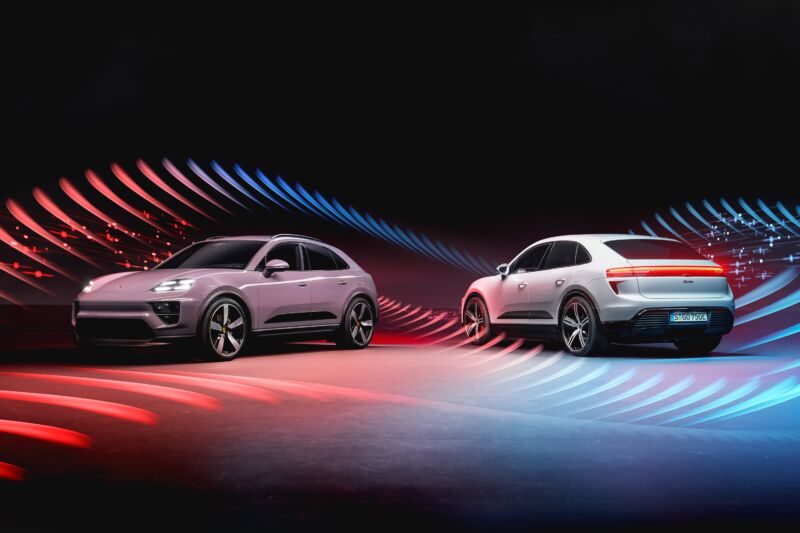Porsche’s order books for the Macan are open, deliveries in the second half of 2

This morning, Porsche unveiled its next Macan SUV. It has dropped internal combustion engines in the process—the new Macan is entirely battery electric, built on a dedicated EV platform. We’ve been following the car’s development for some time, but today’s news fills in a lot of the gaps, and it’s the first time we’ve seen the Macan not covered in camouflage. Porsche is launching with two specifications. There’s a Macan 4 that starts at $78,800, and a Macan Turbo starting at $105,300.
Last year Ars took a dive into the engineering that has gone into the new Macan and its underlying architecture, a new platform called PPE or Premium Platform Electric. Developed together with Audi, it uses an 800 V powertrain that’s an incremental improvement upon the one you’d find in a Porsche Taycan.
We also already know it’s fun to drive, especially the Macan Turbo. Rear-wheel steering makes it very nimble, and the two-valve dampers do a good job of making you think the car weighs less than it does. The Macan 4 isn’t a slouch and can send up to 402 hp (300 kW) and 479 lb-ft (650 Nm) to its wheels, so launching up a highway on-ramp to 60 mph should take 4.9 seconds.
- To start, there are two trims for the Macan. The Macan 4 is the entry level car for now. Porsche
- The Turbo is the one to pick if you want to go fast. Porsche
- The disguised prototypes we’ve seen up until now always looked a little ungainly around the rear. Porsche

The Macan Turbo is just plain quick: up to 630 hp (470 kW) and 833 lb-ft (1,130 Nm). Porsche says it will reach 60 mph from a standing start in 3.1 seconds, and from the way it accelerated on uphill stretches and steep grades gives me no reason to doubt that. Top speed is 136 mph (219 km/h) for the Macan 4 and 161 mph (260 km/h) for the Macan Turbo.
Now that we can see it in something other than dusty black with detail-obscuring stickers, it’s clear how close Porsche has stuck to the Macan styling recipe. It’s a pretty slippery shape, with a drag coefficient of 0.25, courtesy of some active (and passive) aerodynamic devices like shutters that can shroud radiator inlets when cooling isn’t needed.Advertisement
“With the all-electric Macan, we are presenting the first Porsche that we are taking electric from an established product identity,” said Porsche VP for Styling Michael Mauer. “The new Macan is clearly recognizable by its brand identity as part of the Porsche product family. The classic Porsche proportions have been further developed and optimally adapted to the challenges of an electric vehicle. This has further heightened its sporty, modern, and dynamic appearance. The design makes it clear: the Macan remains the sports car in its segment, even in electric form.”
- You sit about an inch lower in the new Macan than the old one. The interior LED lighting is very customizable, so don’t feel you need to make yours green unless you like it. Porsche
- Here’s what the interior looks like in a more traditional (and sombre) black. Porsche
- When you see “Turbo” on the back of a Porsche now it just means that’s the more powerful powertrain. It even makes cars with turbos that don’t say Turbo on the back. Porsche

The electric Macan should be more practical than the existing one. There’s a bit more room in the cabin, particularly in the back seat, thanks to a more space-efficient layout than was possible with the old ICE platform. There’s a 2.9 cubic foot (82 L) frunk under the hood, and another 18 cubic feet (510 L) cargo volume in the back with the rear seats in use, which expands to 46.5 cubic feet (1,316 L) if you fold them down.
Porsche (together with Audi, Scout Motors, and Volkswagen) announced in December it would move to the J3400 DC fast-charging stand, formerly known as the North American Charging Standard, or NACS. The move means access to the Tesla Supercharger network, but not until 2025. Expect model-year 2024 Macans to bear CCS1 fast-charging ports (as well as a second J1772 AC port on the other side).
At an 800 V DC fast charger, the Macan can accept rates of up to 270 kW, charging from 10–80 percent in 21 minutes. At a 400 V DC fast charger, the battery effectively splits itself into a pair of 400 V packs, each of which can charge at a maximum rate of 135 kW.
- The Macan uses a 91 kWh battery pack. Porsche
- The rear drive unit uses silicon carbide power electronics. Porsche
- Even without this frunk, the new Macan would have a few more cubic feet of storage than the old car. Porsche

Some details, like its EPA range, won’t be known until closer to first Macan deliveries. Those are due to begin in the second half of this year, Porsche says.




